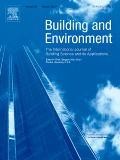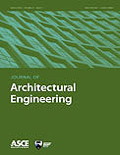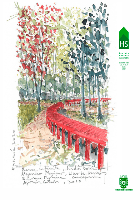
BUILDING AND ENVIRONMENT
Scope & Guideline
Building a greener tomorrow through impactful research.
Introduction
Aims and Scopes
- Indoor Environmental Quality (IEQ):
Research in this area examines how indoor conditions, including air quality, thermal comfort, lighting, and acoustics, affect occupant health, productivity, and well-being. This includes studies on pollutants, temperature variation, and innovative control systems. - Sustainable Building Practices:
The journal publishes studies on sustainable design, construction materials, and energy-efficient systems. This includes life cycle assessments of building materials, strategies for reducing carbon footprints, and the integration of renewable energy sources. - Thermal Comfort and Energy Efficiency:
A significant focus is on thermal comfort modeling, adaptive behaviors of occupants, and the energy performance of buildings, particularly in varying climatic conditions. Research often evaluates new technologies and methodologies to optimize energy use. - Ventilation and Air Quality:
The journal covers research on ventilation strategies to enhance indoor air quality, control airborne pathogens, and reduce energy consumption. This includes studies on natural ventilation, mechanical systems, and the effects of design on airflow. - Urban Microclimates and Heat Islands:
Research addresses the impacts of urban design on microclimates, particularly the urban heat island effect. Studies explore how vegetation, building morphology, and materials influence local temperatures and energy use. - Human-Building Interaction:
This area focuses on the psychological and physiological responses of occupants to their built environment. It includes studies on user preferences, behavioral adaptations, and the impact of design features on mental health.
Trending and Emerging
- Smart Building Technologies:
There is a growing trend towards the integration of IoT, AI, and machine learning in building management systems. Research explores how these technologies can optimize energy use, enhance occupant comfort, and improve indoor environmental quality. - Health and Wellbeing in Built Environments:
An increasing number of studies focus on the relationship between the built environment and health outcomes, particularly in light of the COVID-19 pandemic. This includes assessments of air quality, thermal comfort, and psychological wellbeing. - Resilience and Adaptation to Climate Change:
Research on building resilience against climate change impacts, including extreme weather events and urban heat islands, is gaining prominence. This area emphasizes adaptive designs and technologies that can mitigate climate-related risks. - Sustainable Urban Design and Green Infrastructure:
An emerging focus is on the role of urban design and green infrastructure in enhancing sustainability and livability in cities. Studies investigate how urban greenery can improve air quality, reduce heat, and promote biodiversity. - Decarbonization in Building Sector:
As global attention shifts towards reducing carbon emissions, research on strategies for decarbonizing the building sector is becoming more prevalent. This includes life cycle assessments and innovative building materials that contribute to lower emissions.
Declining or Waning
- Traditional Building Materials:
Studies focusing solely on conventional building materials without considering the integration of sustainable practices or innovative materials have decreased. There is a growing trend towards exploring alternative materials and methods. - Simple Ventilation Systems:
Research on basic or traditional ventilation systems is becoming less frequent as the focus shifts towards advanced, energy-efficient, and adaptive ventilation strategies that incorporate smart technology and occupant interaction. - Generalized Thermal Comfort Studies:
While thermal comfort remains a key area, generic studies without specific contextual applications or innovative approaches are declining. The emphasis is shifting towards personalized and adaptive models that consider individual differences and dynamic conditions. - Static Energy Efficiency Models:
There is a noticeable decline in studies that propose static models for energy efficiency, as researchers increasingly focus on dynamic, real-time monitoring and predictive models that incorporate occupant behavior and environmental variations.
Similar Journals

Russian Journal of Building Construction and Architecture
Fostering Dialogue in Architectural and Construction PracticesRussian Journal of Building Construction and Architecture (ISSN: 2542-0526; E-ISSN: 2542-0526), published by the esteemed Voronezh State Technical University, serves as a vital platform for disseminating innovative research and practical applications in the fields of building construction and architecture. This journal, situated in Voronezh, Russia, aims to explore both the theoretical and empirical aspects of contemporary architecture and construction practices, fostering a robust dialogue among researchers, professionals, and academics. With an emphasis on open access to knowledge, the journal significantly contributes to global discourse by ensuring that findings are accessible to a wide audience. Underlining the importance of sustainable development and cutting-edge technologies in construction, the journal strives to publish high-quality research that addresses the challenges faced in today’s building environment, making it an invaluable resource for those committed to advancing the industry.

Journal of Architectural Engineering
Shaping Sustainable Environments Through Innovative EngineeringThe Journal of Architectural Engineering, published by the ASCE (American Society of Civil Engineers), stands as a pivotal resource in the interdisciplinary fields of architecture and engineering. With an ISSN of 1076-0431 and E-ISSN 1943-5568, this journal has garnered a notable reputation since its inception in 1995, currently converging towards 2024. Boasting a Q1 ranking in Architecture and Visual Arts and Performing Arts, alongside respectable Q3 rankings in Building and Construction and Civil and Structural Engineering, the journal places itself in the elite class of scholarly publications, evidenced by its impressive Scopus rankings. Its commitment to providing cutting-edge research ensures comprehensive coverage across various aspects of architectural engineering, facilitating robust interdisciplinary dialogues. Although the journal operates under a traditional access model, its impact on the academic community remains profound, making it an essential platform for researchers, professionals, and students who seek to push the boundaries of knowledge in their respective fields. This journal not only aims to stimulate innovative ideas but also fosters a collaborative environment for advancing sustainable architectural practices in a rapidly evolving built environment.

Revista Habitat Sustentable
Shaping Sustainable Futures in Architecture and EngineeringRevista Habitat Sustentable, published by UNIV BIO-BIO in Chile, is a dynamic open access journal that has been contributing to the fields of architecture, engineering, and sustainable development since its establishment in 2011. With an ISSN of 0719-0700, this scholarly platform stands out for its commitment to disseminating high-quality research that addresses pressing issues in sustainability and urban planning. Currently, it holds commendable rankings in several categories, including Q2 in Architecture and Q3 in Urban Studies, reflecting its growing influence and outreach across various disciplines. The journal's mission is to foster interdisciplinary dialogue and encourage innovative approaches to habitat sustainability, making it an essential resource for researchers, professionals, and students engaged in addressing the complex challenges of our built environment. Accessible to a global audience, the Revista Habitat Sustentable is poised to play a pivotal role in shaping future research and policy in sustainable living and development.

International Journal of Built Environment and Sustainability
Connecting Ideas for a Greener Built EnvironmentInternational Journal of Built Environment and Sustainability, published by PENERBIT UTM PRESS, serves as a pivotal platform for the dissemination of research in the fields of architecture, urban planning, and sustainable development. With an E-ISSN of 2289-8948 and having embraced Open Access since 2014, this journal ensures that critical findings in built environment research are accessible to a global audience, fostering innovation and collaboration among researchers, professionals, and students. Although the H-index and specific scope are currently not detailed, the journal's commitment to advancing sustainable practices in the built environment makes it an invaluable resource for those dedicated to tackling the pressing challenges of sustainability in our communities. As part of its mission, the journal prioritizes high-quality, peer-reviewed articles that contribute to both academic theory and practical applications, solidifying its role in shaping the future of our built environments.

Japan Architectural Review
Unlocking insights into Japan's architectural evolution.Japan Architectural Review is a premier open-access journal published by WILEY, dedicated to advancing the fields of architecture, environmental engineering, and modeling and simulation. Since its inception, this journal has emerged as a critical platform for disseminating innovative research, offering insights into the latest trends and challenges facing the built environment and sustainability practices. With an impact factor reflecting its growing influence, especially in the Q2 category of Architecture and notable rankings in environmental engineering and modeling disciplines, it serves as an essential resource for researchers, professionals, and students alike. The journal's commitment to open access since 2018 has further enhanced its reach, making high-quality research accessible to a global audience. Spanning an important timeline from 2019 to 2024, the Japan Architectural Review facilitates a collaborative discourse among scholars, encouraging innovative solutions to contemporary architectural challenges.

Intelligent Buildings International
Advancing Smart Solutions for Sustainable ArchitectureIntelligent Buildings International, published by Taylor & Francis Ltd, is a premier journal dedicated to advancing knowledge in the interdisciplinary domains of building construction, civil engineering, computer science applications, and planning. Since its inception in 2009, this journal has become a vital resource for researchers, professionals, and students, offering a platform for high-quality scholarly articles that explore innovative strategies and technologies in intelligent building design and efficiencies. With its significant impact factor reflected in its Q2 and Q3 quartile rankings across various related fields, and strong Scopus rankings placing it among the top journals in Geography, Building, and Civil Engineering, Intelligent Buildings International stands out for its commitment to fostering research that enhances the sustainability and functionality of contemporary architectural practices. Readers can access a wealth of articles that illuminate the complexities of smart building technologies and their implications for future construction practices, making it an essential addition to any academic library.

International Journal of Ventilation
Connecting Academia and Industry for a Sustainable FutureThe International Journal of Ventilation, published by Taylor & Francis Ltd, serves as a critical platform for the dissemination of innovative research in the fields of building and construction, civil and structural engineering, control and systems engineering, and electrical and electronic engineering. With an ISSN of 1473-3315 and an e-ISSN of 2044-4044, this esteemed journal has maintained a significant presence since its inception in 2005 and continues to provide valuable insights for academics and professionals alike until 2024. Recognized in the 2023 rankings, it holds a Q2 designation in Building and Construction and Q3 status in several other engineering categories, reflecting its solid standing in the academic community. Despite its non-open access format, the journal remains a vital resource, focusing on advanced ventilation solutions that shape sustainable practices in building design and engineering systems. By publishing high-quality peer-reviewed articles, the International Journal of Ventilation plays a pivotal role in advancing knowledge, fostering collaboration, and inspiring future research within its dynamic fields of study.

Frontiers in Built Environment
Connecting researchers to the forefront of built environment challenges.Frontiers in Built Environment, published by FRONTIERS MEDIA SA, is a highly regarded open-access journal that has established itself as a significant platform for cutting-edge research in the fields of building and construction, geography, planning and development, and urban studies. Since its inception in 2015, this journal has embraced a commitment to disseminating high-quality, peer-reviewed research, allowing researchers, professionals, and students to access pivotal findings and insights without financial barriers. With an impressive 2023 impact factor, it ranks in the Q1 tier for Urban Studies and is positioned within the Q2 tier for both Building and Construction and Geography, Planning and Development, demonstrating its influence and relevance in evolving urban and environmental challenges. Its rigorous indexing, exemplified by a strong Scopus ranking, reflects its contribution to the advancement of knowledge in these critical areas. With a clear dedication to fostering innovation and collaboration within the built environment sector, Frontiers in Built Environment is essential reading for those engaged in shaping sustainable urban futures.

Gradevinar
Innovating Infrastructure Solutions for a Sustainable FutureGradevinar, published by the Croatian Society of Civil Engineers-HSGI, is a leading Open Access journal in the field of Civil and Structural Engineering, with a significant history that dates back to its inception in 1980. This journal, with the ISSN 0350-2465 and E-ISSN 1333-9095, has established itself as a vital platform for disseminating innovative research and practical developments in civil engineering, particularly since it became Open Access in 2000, facilitating unrestricted access to its wealth of knowledge. As of 2023, Gradevinar is ranked in the third quartile (Q3) of Scopus’s Civil and Structural Engineering category, demonstrating its growing influence and relevance in the academic community, with a current ranking of #255 out of 379 journals in the field. Researchers, professionals, and students benefit from this journal's commitment to high-quality content that reflects the latest advancements and best practices in civil engineering, contributing to both technical proficiency and sustainable development in infrastructure projects across Croatia and beyond.

Bauphysik
Bridging Theory and Practice in Building ConstructionBauphysik, published by ERNST & SOHN, is a prestigious journal dedicated to the fields of architecture, building construction, and environmental engineering. With a strong focus on the principles of building physics, Bauphysik serves as a key platform for researchers, professionals, and students alike, disseminating vital information and advancements within the industry. The journal, boasting an ISSN of 0171-5445 and an E-ISSN of 1437-0980, is well-regarded with a categorization in the Q2 quartile in Architecture and Q4 quartiles in Building and Construction and Environmental Engineering as of 2023. Its Scopus ranks further highlight its impact within the community, with rankings of 83/189 in Architecture, 179/223 in Building and Construction, and 167/197 in Environmental Engineering. Despite its lack of open access options, the journal's retrospective convergence from 1982 to 2024 marks its long-standing influence in advancing building physics research. With a dedicated readership, Bauphysik encourages the exploration and sharing of innovative solutions to contemporary challenges in the built environment.